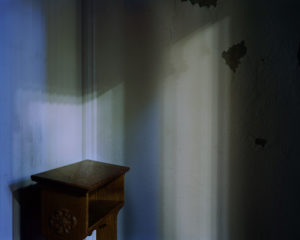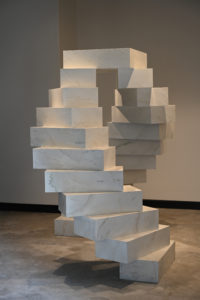MyLoan Dinh majored in visual arts at the University of North Carolina at Chapel Hill and the School of Arts and Design at Wollongong University New South Wales, Australia. She has exhibited internationally, and her work can be found in public and private collections in the United States and Europe, including the Muhammad Ali Museum and Center, ArtFields, the Mint Museum of Art, and the Imago Mundi Collection of the Benetton Foundation. www.myloandinh.com
Image: Can you talk a bit about where you were born and grew up?
MD: I was born in Saigon. In 1975, during the last days of the US war in Vietnam, my family and I escaped by sea. After moving between refugee camps at Wake Island, Subic Bay in the South China Sea, and finally Camp Pendleton in California, we were resettled by a Lutheran church in the Appalachian Mountains in Boone, North Carolina. One year later we moved to Charlotte, where I spent most of my formative years. You could say I’m a Southeast Asian American Southerner.
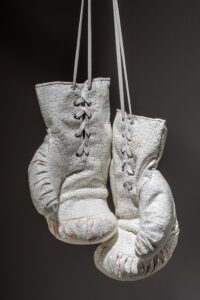
MyLoan Dinh. Off White, 2019. Mixed media with eggshells, boxing gloves, and acrylic. 18 x 13 x 5 inches. Collection of the Mint Museum of Art. Photo: Jeff Cravotta.
Image: How have you explored your experience as a refugee in your work? Have you found yourself accessing different memories or understandings of that experience over time?
MD: My story as a refugee and immigrant is often a starting point in my work. I’ve tried to learn to hold the specificity of my experience in tension with a desire to connect with universal dimensions of being human. Both of these poles, of course, are subject to the slippery proclivities of the imagination, memory, storytelling, abstraction, and so on.
I was trained as a fine arts painter. From early on, my works referenced my culture and past-sometimes too much for my college professors. A professor once told me a self-portrait was too “ethnic,” too “Oriental,” and I was so young and impressionable I burned the painting. I wince now when I think about it. My name means phoenix in Vietnamese.
I recently completed a new work for the Benetton Foundation, Return to Sender, Tent #8, which integrates my eggshell work, a family photo from a refugee camp, and textile. The fabric is from the globally iconic cheap tricolor carryall-a symbol of migration with a checkered historical and political past. While recognized for their resilience, these bags are often given derogatory nicknames: “Ghana Must Go” bags in Nigeria; “Türkenkoffer” (Turkish suitcase) or “Vietnamesenkoffer” (Vietnamese suitcase) in Germany; “Guyanese Samsonite” in the Caribbean; “Bangladeshi bags” in England; “Zimbabwe bags” in South Africa; and “Chinatown totes” in the United States. With this work, I explore the material cultures of those evocative objects, with their partially hidden histories pertaining to class, ethnicity, race, and power.
Image: You’ve split your time between North Carolina and Germany in recent years. How does working in these different milieus inflect your work? Do you ever find the same piece taking on different shapes as it evolves across borders?
MD: I feel very lucky to live and work in two vastly different places, Charlotte and Berlin. My husband is German. He’s a choreographer and founder of Moving Poets, a multidisciplinary arts organization, so we spend time on creative projects in different countries. Geography certainly affects the creation of work. I grew up in the US South, which is predominantly and overtly Christian, in striking contrast to Berlin, which in my experience is very secular. Germans are very private about their religion, which is mainly Catholic or Protestant, and nearly half of Germans have no religion. I do take into account cultural and religious sensitivities when I’m exhibiting my work. Context is important. Sometimes I’ll alter a work if I feel it will not read well.
Last summer I performed Longing for harmonies both in Charlotte and in Berlin. The thirty-minute performance installation includes a wedding dress, hazmat suit, paper parasol, ghost money, scissors, wooden beads, needles, eggshells, and an áo dài (a traditional Vietnamese dress): these are my symbolic protagonists. This performance makes public an array of private questions-of maternity, migration, culture, and history-and is haunted by centuries of prejudice against Asians and sexual violence against Asian American women. I wasn’t quite sure how it would resonate in Berlin, because there is substantial English text and references to US colonial history. I did not change the work for the German audience. I was pleasantly surprised it resonated so well, even the nuanced bits.
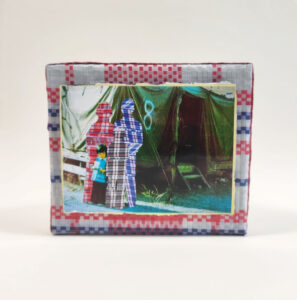
MyLoan Dinh. Return to Sender, Tent #8, 2023. Mixed media with eggshells, polypropylene and cotton fabric, paper. 4¼ x 5½ x 2 inches. Collection of the Benetton Foundation. Photo courtesy of the artist.
Image: Has the recent spike in anti-Asian violence in the United States influenced how you talk about your work or the themes you explore?
MD: Anti-Asian discrimination is part of the fabric of American colonial and imperial history (think of the Chinese Exclusion Act, Japanese internment camps, the Vietnam and Korean wars, and so on). Within our communities, we knew the tide was coming. And during the pandemic, after the ex-president used xenophobic rhetoric to scapegoat Asians, hate crimes against Asian Americans rose over three hundred percent.
After the Atlanta spa shootings, as the nation confronted difficult conversations, my own response was intense. I have family and friends who work in nail service, so I was in intimate proximity to this horror. I created an installation titled Treat Yourself. I was reminded of the image of Christ washing the feet of his disciples. What was especially important to me, though, was how images of water, foot washing, and bathing span time and space (the US, Europe, Asia, the Middle East) and thus play into global entanglements. I thought about how, as a society, we haven’t understood this lesson of humility and service: we don’t know what it means to wash one another’s feet, just like we haven’t comprehended the meaning of “love thy neighbor.” Only some are doing the washing.
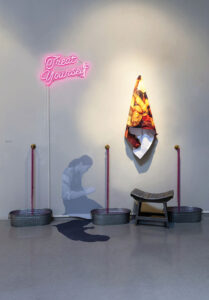
MyLoan Dinh. Treat Yourself, 2022. Mixed-media installation with neon light, metal spigots, plastic beads, towel, metal tubs, photo on vinyl, wood stool. Photo: Jeff Cravotta.
Image: You often play with cultural inheritance, bringing both poignant and satirical elements into play, especially in your eggshell series. Can you talk a bit about the process and traditions behind those works?
MD: Since 2016, I’ve increasingly used eggshell mosaics in my mixed-media work exploring gender and race. Covering objects in eggshells requires time-consuming labor, care, and focus-attention and intention. My eggshell-based work arose from formal experimentation and latent early exposure to sơn mài inlay lacquerware, an often overlooked traditional craft I saw growing up in a Vietnamese household.
The interplay of materials and objects creates a dialogue between the collective and the individual. What is glimpsed between the cracks of the shells is as important as what is reassembled on the surface. The series probes a set of cultural tensions. Boxing gloves, though physically soft, bear connotations of violence and masculinity. Eggshells, by contrast, are traditionally associated with femininity and delicateness. Though fragile, they also evoke shelter, nourishment, and fertility. My first pair of eggshell boxing gloves was titled Killing Me Softly.
Image: Your work investigates both Buddhist and Christian iconography and themes. Are there key elements you find yourself revisiting in both traditions? Are there places where they intersect for you?
MD: My relationship with religion is complicated and ambivalent, and my spiritual identity is conspicuously composite-I was raised in a traditional Southeast Asian Buddhist household and educated in public schools in the predominantly Christian US South. These geographic, social, cultural, and religious influences have significantly shaped my perspective. In my recent work I’ve been using prayer beads-rosaries and malas-in installations consisting of paintings of praying hands and physical objects. I want to find an opening for viewers to connect across cultural barriers.
Last year I created an installation titled Zoom Buddha, which channels the work of Nam June Paik. Communications technology has rapidly evolved since his legendary 1974 installation TV Buddha, yet questions to do with the role of the self in relationship to media and technology are increasingly relevant. The piece honors his legacy and reimagines his work in the context of the Covid pandemic, social media, AI, and virtual communication. Like Paik’s, my Buddha gazes at his own image on the screen in an everlasting staring contest that raises questions of self and humanity.
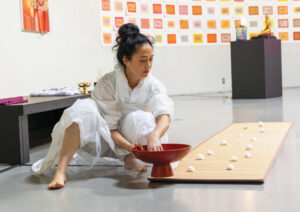
MyLoan Dinh. Longing for harmonies, 2022. Still from 30-minute performance work. Photo: Jeff Cravotta.
Image: Do you have a particular ritual when working in your studio, whether straightforwardly religious or not?
MD: Sometimes I burn incense and make a prayer before I start working. That’s the most straightforwardly religious I get. I’m most spiritually centered when I’m intensely absorbed in work. Letting go of the “thinking” part of making allows me to subconsciously connect to something greater than myself. When I’m feeling deeply interwoven-entangled with the universe-I’m energized and yet at ease.
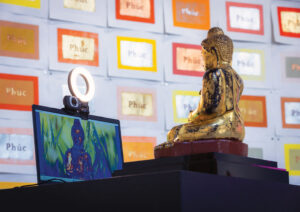
MyLoan Dinh. Zoom Buddha, after Nam June Paik, 2022. Installation view. Mixed-media installation with gilded, inlayed nineteenth-century wooden Buddha, mini camera, light halo, laptop. Photo: Jeff Cravotta.
Image: Are there spiritual or philosophical questions you find yourself struggling with over and over in your work?
MD: Questions of identity, consciousness, and othering are constant in my work, perhaps because they’re at the root of many complex problems in society. I struggle with the contradictions between spiritual teachings and actual practice. Besides the unspeakable violence that’s been levied in the name of religion, Christ and Buddha are too often invoked superficially. My work isn’t intended to teach anything or claim any moral high ground. I don’t even think I provide any conclusions. Rather, I hope to provoke the viewer to ask questions that I myself cannot answer. Sometimes there’s a dark irony in my work. If there’s any laughter, it’s mixed with tears.





